BOOMERANG SHOP
BOOMERANGS FOR SALE
Buy a Boomerang Now Online and Learn How to Throw a Boomerang!
HOW MUCH DO BOOMERANGS COST?
The best way to answer this question is to look at the different types of Boomerangs that are available. The cheapest option is the standard Boomerang, which can be purchased for $10. There are also premium Boomerangs, which cost between $30 and $40.
There are boomerang for kids or adults. Learn how to throw and catch boomerangs with illustrated boomerang instructions and Youtube “boomerang how to videos” about how to correctly throw a boomerang to get a perfect flight!
You will find here many things about the boomerangs (Two-bladed boomerangs, three-bladed boomerangs, Finnish birch boomerangs, as well as bakelite boomerangs, etc…), from the design of two-bladed or three-bladed boomerangs to the killing sticks, from the launching to the manufacturing, including a free plan to create your own boomerang, the theory of the flight of the boomerang, and infos about boomerang competitions.
The manufacture of a two-bladed or three-bladed boomerang will be exposed to you, as well as the broad outline of the design of a model of boomerang, the way to launch a boomerang to obtain a precise return of the boomerang, etc…
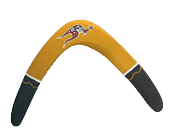
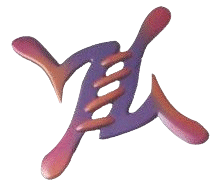

WHAT IS A BOOMERANG?
Its basic structure is relatively simple: at least two blades with a certain profile, joined to each other at one end, located in the same plane, and whose longitudinal axes form a more or less closed angle between them. When thrown by hand in an appropriate manner, it flies while spinning around, describes a curved trajectory, and returns to the immediate vicinity of its starting point.
We will consider here the case of the right-handed boomerang. Left-handed models are also available on the market. They simply have the opposite shape, trajectory and rotation of right-handed people. A left-handed model is an exact replica, seen in a mirror, of a right-handed model.
The anatomy of the boomerang is simple, but it has some essential characteristics for its flight. It has a flat side, called the underside, and a curved side, the upper side.
Observe the curved side: the thickness is not the same over the entire surface. Each blade has a thick edge (called the leading edge) and a tapered edge (the trailing edge). The profile of each blade is similar to that of an airplane wing. In order to get lift, the airplane wing has to split the air at its thickest edge. The same applies to the boomerang: as it rotates, each blade attacks the air through its thickest edge, the leading edge.
The characteristics are very variable.
For example, the wingspan generally varies from 20 to 50 centimetres, the thickness from 2 to 10 millimetres. The profile and shape given below are the basic ones, but there are a multitude of them. A “classic” boomerang is composed of two blades, but there are all kinds of shapes, including three-bladed boomerangs, which are often easier to throw but also more efficient and much more widespread in competition. There are even indoor foam boomerangs.
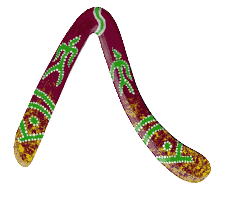
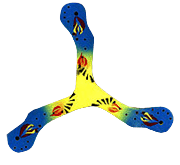

ORIGIN OF THE BOOMERANG
The origin of the boomerang goes back to prehistory. It is in Australia that it has developed the most, in fact the boomerang throwing is derived from a customary practice of certain aboriginal tribes.
It has nevertheless been found in many countries. Contrary to a persistent legend, the boomerang has never been used as a weapon. Due to its low weight, it does not have a sufficient impact. Throwing was simply a game much appreciated by the Aborigines.
The ancestor of the boomerang is the “Killing-stick” because in Australia, Aboriginal tribes knew about Killing-sticks long before the boomerang.
But these devices were known elsewhere. Indeed, in excavations in Florida and northern Europe, in the tombs of Egyptian pharaohs, Killing-sticks more than 3000 years old have been found.
Curved sticks used for hunting birds are frequently depicted in frescoes in ancient Egypt and in rock carvings in the Sahara. Thus, it is with the killing-sticks that the aborigines hunted and not with the boomerang. Killing-sticks are bigger and heavier than the boomerang, and are unable to return.
Today the boomerang has become a sport. After Australia, it has gradually established itself in the United States and Europe. In France, boomerangs started to be marketed in 1978. The FNAC-Sport (a department store in Paris), for example, sold an average of 5 per month that year. In 1982, the followers of this new sport (or game) could hesitate between 10 times more models. They bought 150 per month.The fashion seems to have caught on.
The 1st world championship took place in Paris in 1985. Also, the multiplication of clubs and competitions can be interpreted as the harbinger of a spectacular expansion of this new discipline, which is gaining its letters of nobility. The boomerang is a very complete activity and there is something for everyone.
Indeed, it is at the same time an artistic, manual, technical, scientific, ethnological and sporting activity. Moreover, the boomerang is an inexhaustible source of research and discovery.
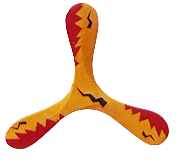
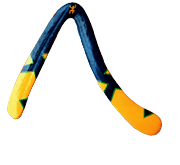

INSTRUCTIONS FOR USE
Caution is called for. Even though a boomerang is completely incapable of causing injuries such as those seen in one of the shocking scenes in “Mad Max”, where a young warrior kills his enemies with a sharp-edged boomerang, don’t throw it if someone is likely to get in the way. A boomerang is easily lost if you’re not careful where it lands. Never take your eyes off it; who has never looked for an apple green boomerang on a soft grass lawn doesn’t know hell! You must certainly see what I mean… 😉
Also avoid catching the boomerang when it comes back to face height and avoid throwing if the wind is too strong. You never know exactly where a boomerang is going to land. So you have to choose a rather big field (grass). Watch out for trees (it clings to them) and rocks (it breaks). Finally, be careful not to store your boomerang anywhere because the slightest deformation can be fatal to it.
The 5 basic rules can be learned in 10 minutes. But then, you have to practice with more or less assiduity to become an expert. It depends on the boomerang and your ability to correct your throws. And if finesse counts more than strength, it is however not negligible to be in good physical shape.
Throw at 45° to the right of the wind. The wind is the pitcher’s number one partner. First of all, find out where the wind is coming from. Throw at an angle of about 45° to the right of the headwind. That is the wind angle. Note that the majority of boomerangs come back even without wind.
Face bowed to the left. The dished side must be turned towards the inside of the trajectory, i.e. to the left. This condition is imperative for the blades to split the air by their leading edge. The boomerang can be launched by either blade.
Tilt 20° to the right of the vertical. The boomerang should leave your hand in a position, slightly tilted (about 10° to 30°) to the right. This angle is sufficient to counterbalance gravity. The boomerang will therefore launch in a plane close to the vertical.
Slightly upward trajectory. In general, the boomerang is given a slightly upward trajectory. The boomerang extends until it forms a vertical angle with the horizontal (about 10 degrees).
Sharp relaxation of the arm. Launch by unrolling the arm, as if you were whipping. The thrower’s arm acts like a catapult: first bent back over the shoulder, it extends sharply forward. The gesture is comparable to that of a tennis serve. It is the relaxation of the arm that gives the boomerang the impulse necessary for its flight. It stores at this moment a considerable amount of energy which it will disperse throughout its trajectory. At the end of the trigger, with a sharp gesture, the thrower’s hand gives the boomerang a rotational movement on itself. The higher the speed of rotation, the more stable the flight is. It is essential to give the boomerang a high rotational speed.
The 3 angular parameters are : Wind angle, line of sight (vertical angle) , and tilt of the boomerang at the start. They condition the flight and the return of any boomerang. The throw must be adapted to the type of boomerang used and to the aerological conditions of the moment (see figures). According to the wind strength, the thrower must dose his effort, play with the wind angle, vary the inclination and the vertical angle in order to obtain the most accurate return possible. The inclination of the device is one of the most important parameters.
The more the boomerang is tilted horizontally, the faster and higher it rises. But be careful, almost all beginners have a tendency to release the boomerang that is too inclined. In any case, the absolute rule is never to throw a boomerang horizontally: it flies very fast vertically and falls down at high speed with serious risks of breakage.
- Correct your trajectories and you will progress quickly.
- If your boomerang falls halfway, then throw harder and with more rotation or more inclination to the right.
- If it falls too far to your left, then throw further to the right of the wind or lower on the line of sight.
- If it falls too far to your right, then throw further to the left of the wind or higher on the line of sight.
- If it rises too high, please make sure that your boomerang is almost vertical when it leaves your hand.
- If it is blown away by the wind, then throw higher on the line of sight and more vertical.
The easiest catch is the “sandwich” catch. This involves putting both hands flat on the boomerang and then pressing them down hard on the boomerang when it comes back. It is also necessary to anticipate.
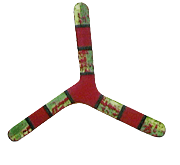
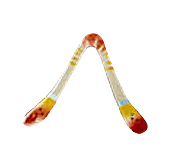
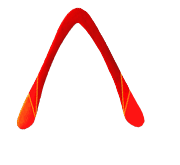
MANUFACTURING THE BOOMERANG
The equipment you need is inexpensive. Plywood, a wire saw or jigsaw, a rasp, sandpaper, paint, and three hours of work are enough. Most boomerang enthusiasts make their own boomerang.
In this section, we will see how to make a boomerang out of a board of okoume plywood because this material is easy to find, it is also the cheapest and easiest to work with, but it is quite fragile. There is also the aviation birch (4 or 5 mm), practically non-deformable and resistant. We can also use various plastics and synthetic materials (Bakelite, PVC, Polypropylene, Polycarbonate, ABS, Forex, …).
The 5 steps suggested below are suggestions, a multitude of other solutions are possible. The profile is the basic one, you can modify it according to the specific flight you are looking for.
1- Cutting. The boomerang shape is cut out of a 4 mm thick Finnish Birch (or Aviation) plywood board. It is rare for a wooden board to be perfectly flat. Make sure that the extrados (the domed side) of the boomerang is made on the concave side of the board. Otherwise, the boomerang may crash after a few meters of flight.
2- Shaping. The boomerang must be shaped to give its blades the shape of an airplane wing. To do this, use a pencil to draw guide lines on the upper surface of the boomerang, which will serve as a reference when you grater. The elbow: at the top of the elbow, let the leading edge encroach far enough on the trailing edge. Leading edge: Grasp at a 45° angle and stop as soon as you reach the centre crease and guide line. Trailing edge: start from the guide line and rasp towards the gently sloping edge, making sure that the sanded surface remains flat. The trailing edge should be thin but not tapered. Leave about 2 mm. The blade tips: this is a part to be treated. The transition from attack to continuation should be gradual.
3- Finishing. This involves removing the bites left by the rasp, levelling out irregularities and breaking the sharp edges into “a”, “b” and “c”. You can use a sanding block with coarse then very fine sandpaper to make the boomerang very smooth.
4- Tests. The boomerang you have just made will probably need corrections to obtain the desired flight. If you are a beginner, it is advisable to get help from a more experienced launcher. In general: Sanding in “b” or “c” will increase the lift. Sanding in “a” decreases lift.
5- Painting. The paint will be used to decorate and protect the boomerang, especially from humidity. Protected in this way, the wood is less likely to warp. Apply two coats. Painting your boomerang with bright colours will allow you to follow its flight easily and to locate it in the greenery.
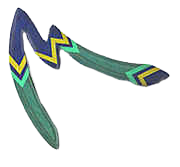
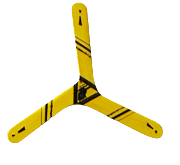

BOOMERANG COMPETITIONS
National and international competitions are organized every year, both indoor and outdoor. The boomerang community is structured and well organized.
There are 9 type of boomerang disciplines or events :
- General championship: (Aussie Round) on 5 throws, you get points for distance, accuracy, catching.
Formerly the Catch-up acrobatics (12 imposed catch-ups: 1 and 2 hands, under the leg, in the back, with the feet, worth 1 point each …) have been replaced by a new event: - Accro-Doubling which consists of 10 catches with 1 boomerang and a scale according to the difficulty, followed by 10 others in doubling (throwing 2 boomerangs at the same time) also with proportional scale.
- M.T.A. : maximum time in the air.
- Endurance: do the maximum amount of catching up in 5 minutes.
- Accuracy : the boomerang must land as close as possible to the throwing point.
- Speed: take as little time as possible to make 5 catches.
- Distance: the boomerang must go as far as possible and come back behind the thrower.
- Doubling: Catch-up throws imposed on two boomerangs thrown at the same time.
- Juggling: juggling 2 boomerangs, you throw the second one while the first one is in the air and then you catch it.
The results, as in many other areas, are commensurate with the research carried out. It is in fact to this research that the true boomerang lover naturally ends up. Once trained to launch with a good production model, he will want to build with his hands devices adapted to his strength and the performances he is aiming for.
All initiatives being allowed, as long as the machine flies and comes back, the enthusiasts will be able to give themselves to their hearts’ content and savour, in case of success, the rare and strong emotions reserved for the pioneers.
